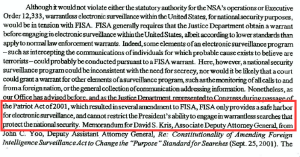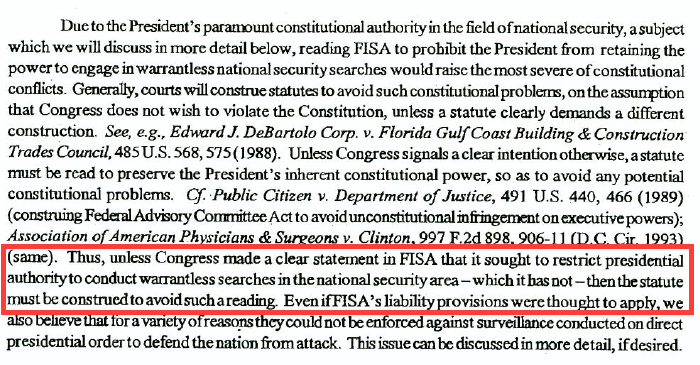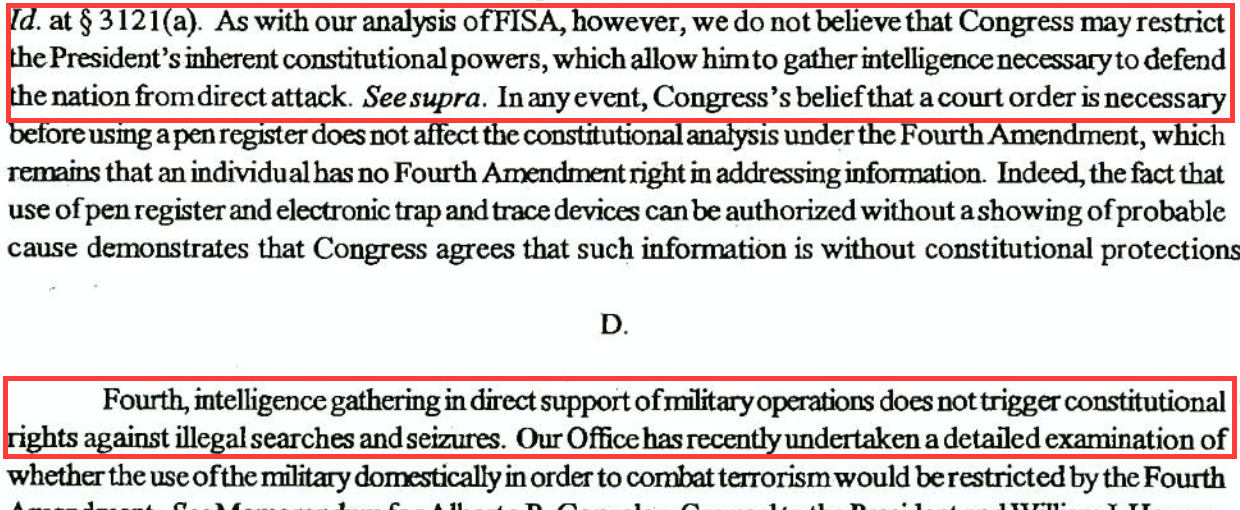John Yoo’s Two Justifications for Stellar Wind
Because I’m a hopeless geek, I want to compare the what we can discern of the November 2, 2001 memo John Yoo wrote to authorized Stellar Wind with the letter he showed FISA Presiding Judge Colleen Kollar-Kotelly on May 17, 2002. The former is almost entirely redacted. But as I’ll show, the two appear to be substantially the same except for small variations within paragraphs (which possibly may reflect no more than citations). The biggest difference is that Yoo’s memo appears to have two pages of content not present in the letter to Kollar-Kotelly.
What follows is a comparison of every unredacted passage in the Yoo memo, every one of which appear in exactly the same form in the letter he wrote to Kollar-Kotelly.
The first unredacted line in Yoo’s memo — distinguishing between “electronic surveillance” covered by FISA and “warrantless searches” the President can authorize — appears in this paragraph in the letter.
The line appears on page 7 of Yoo’s memo, but page 5 of his letter (which also includes some foofy introductory language for Kollar-Kotelly). That says there’s already 2 pages of information in Yoo’s memo that doesn’t appear in the letter. Yoo’s description of the surveillance program in the letter to Kollar-Kotelly is actually fairly short (and written entirely in the conditional voice), so there may be more of that in the actual memo. Also, anything that didn’t involve electronic surveillance — such as the collection of financial data — would not necessarily be relevant to FISC. But as I argue below, it’s also possible Yoo made claims about executive power in those two paragraphs that he rewrote as a two-page addition to for Kollar-Kotelly’s benefit.
The next unredacted passage in the memo consists of the first sentences of these two paragraphs.
They appear on page 9 of Yoo’s memo and page 7 of the letter, and it appears that the space in between the two is consistent — suggesting that the interim content remains the same.
The next unredacted passage appears on page 12 of Yoo’s memo, page 10 of the letter.
While the general pagination still seems to be roughly tracking (again, suggesting the interim content is at least similar), the spacing of this paragraph is clearly different (note how the sentence begins in a different place in the column), suggesting Yoo may have made an even stronger defense of inherent authority in his memo, or perhaps that OLC has precedents for such a claim that Yoo thought inappropriate to share with the FISC. It’s possible this and later paragraph spacing differences arise from classification marks at the beginning of each paragraph, except the passages from the beginning of paragraphs seem to match up more closely than those from the middle of them.

The next unredacted passage, on page 17 of Yoo’s memo and 15 of the letter, extend the claim that Congress can’t limit the President’s use of pen registers used to defend the nation. That’s followed closely by Yoo’s shift to arguing that intelligence gathering “in direct support” of military operations does not trigger the Fourth Amendment.
Again, the pagination of both line up. But as with the discussion of Congress’ ability to impose limitations with FISA, the discussion on pen registers appears to have different spacing within the paragraph.
This citation, from the 1995 Supreme Court decision in Vernonia School District, is the next unredacted passage.
Here, the pagination of the two documents remains close — the line appears on the bottom of page 19 in Yoo’s memo but near the top of page 18 in the letter — but it’s possible there’s somewhat less content in the memo at this point than the letter. And again, the spacing within the paragraph seems to be off slightly.
Two pages later in both documents (page 21 of the memo and 19 of the letter), the quote from Haig v Agee, which the executive always uses to assert expansive powers for national security, appears.
Though once again, the spacing within the paragraph appears slightly different.
That’s the last unredacted passage of Yoo’s memo. The memo released to the ACLU under its EO 12333 FOIA reveals there are 3 more pages to Yoo’s memo (for a total of 24). That would suggest that the remaining body of the documents were, at least, close in length.
That is what the letter has as well. But in addition to the letter, DOJ released an unexplained 2 page description of “Authority for Warrantless National Security Searches” that does not appear in the Yoo memo as far as we know. So the Kollar-Kotelly letter is 22 pages, plus the 2 page addendum, whereas the memo is 24 pages, apparently without it.
Which says one obvious explanation for the difference in length is that Yoo replaced two pages of content from his memo with the two page Authority document.
Half the two-page Authority document deals with citations in Keith, the Supreme Court decision requiring warrants for even domestic security wiretaps; it effectively does this to suggest Keith was more supportive of warrantless wiretapping than it was. The other page treats more recent decisions, all except Congress’ decision to include physical searches in FISA, pre-dating FISA. Some of these citations are even repeated in the letter (so presumably in the memo). It seems, then, that these two pages are a special interpretation of past actions to interpret them as saying something different than they do. (As I’ll note in a future post, the Keith gymnastics are particularly important.)
But I’ll add one more thing. The fact that Yoo had claimed the Executive could ignore the content of EO 12333 first became public when Sheldon Whitehouse got language from the memo declassified in 2007 and read it on the Senate floor (he specifically refers to memos, not letter, so it’s presumably from the November 2, 2001 memo). But Whitehouse also got two more claims declassified at the time:
- The President, exercising his constitutional authority under Article II, can determine whether an action is a lawful exercise of the President’s authority under Article II.
- The Department of Justice is bound by the President’s legal determinations.
I believe the second claim — that DOJ is bound by the President’s legal determinations — refers to a note that Alberto Gonzales sent DOJ after the hospital confrontation. But the first — that the President can determine what is a lawful exercise of his own Article II authority — has not (as far as I can think of) since been made public. So I think it’s possible that the two pages of the memo that don’t exist in the letter might make such a claim (which would in turn justify the October 4, 2001 decisions to authorize the program). In which case, when Yoo was rewriting it to make it palatable to a judge who otherwise might balk, simply rewrote those two pages to make them appear reasonable so long as no one got to review it closely. That’s just a guess, but we know we’re looking for 2 pages of content written by Yoo in 2001, and I believe we’re still looking for the claim that the President can determine whether his own actions are legal, so it’s possible the claim is in those two pages. And some of the later Article II claims that appear in the letter (and the memo) would make more sense if Yoo had made such a case for Article II authority in those missing two pages.
If I’m right, though, it would suggest that DOJ’s claim that it cannot release the November 2, 2001 memo is an effort to ensure those two pages don’t become public, because all the rest has already been made public (in only slightly redacted form).









I agree that Gonzales did that to cover his own ass.
On page 12 of the memo he does not give any details where Congress actually votes against the Constitution, nor does he give dates at which Congress was to deliberate such vote.
We ALL know that we now have that Constitutional Crisis he speaks of. Every member of Congress that okayed this a Treasonous BASTARD! They have allowed Tyranny of Military and Spy Corporations of our Country. It has nothing at all to do with the President’s authority, although Yoo made a big pow-wow about it in the memo. It has more to do with suspending the Constitution and Bill of Rights.
As always, Excellent job. I agree the page differences and line skews would lead any thinking person to suspect. The Patriot Act was the lead in to this and YOO should be in prison for life.
That second determination is terrifying. With that one claim the executive is essentially decimating any pretense that the DOJ is an independent organization or one that acts independently of the executive.
.
This has been the basic presumption and is why the AG is a congressionally-reviewed appointment and not just a staff hire.
.
If this holds it means that the WH can simply tell the AG what to do by means of legal directives and any pretense of the WH being subject to the law is false.
.
.
This provokes a number of interesting questions.
.
First, if this is the case why hasn’t the current POTUS ordered the AG to do more against Wall Street or others. After all President Obama has claimed that he wants to do that and has said that the DOJ said it could not. But armed with the ability to simply “find” that the banks are in need of prosecution he could do that directly.
.
Second, how does this relate to the legal wrangling over the Dreamers? In that case there has been a great deal of court debate over whether or not the president can order the DOJ to do anything. Did the WH advance this argument in court? If so, did it hold? If not, why not? And did the court rulings bear on this question?
.
Third, how does this finding stand relative to the existing DOJ charter? And where else has this power been used?
That el Presidente can determine which of his Art. II actions is lawful – a legal conclusion based on an analysis of constitutional requirements, acts normally reserved to the judiciary – must come as a shock to Art. III judges. (Even the ones in the Eastern District of Pennsylvania, who don’t think a person photographing police exercising their powers is a protected expression under the First Amendment.) A chief executive would always be the last person to conclude that his or her actions, or even those of a predecessor, violated constitutional or statutory requirements. As with the oxymoronic notion of “self-regulation”, this invented presidential power would free the executive from liability for often egregious, illegal conduct.
If my suppositions here are right, then that’s why (I suspect) Yoo didn’t give it to K-K.
Mind you, I’m still a little surprised they released this document, given that it will make it very hard to avoid giving over — or having a judge review! — the original memo. But it would be hard to avoid that, given that it was shared with K-K. All of which is to say, they may not avoid showing a judge ultimately.
I may be wrong that that 2nd proposition appears in those 2 pages. We may end up seeing.
These are fascinating questions of Constitutional authority
and separation of powers. The more I study the Constitution
the more I question the party line that the Fondling Fathers
were omniscient and/or divine. Maybe they were nincompoops,
in fact, and I’m not just talking the BS that is known as the
2nd Amendment. (WTF did Adam Lanza’s right to own and carry
an assault rifle have to do with “a well regulated militia”?)
Somebody needs to give the whole Constitution another look
from an objective PoV.
.
Anyway, the reason I bring it up is that the 4th Amend doesn’t
actually REQUIRE a search or an arrest warrant for anything.
All it says is that “no Warrant shall issue, but upon probable
cause, . . .” This is not a statement that any warrant is required
for any purpose, but, rather, that if a warrant is used it must
meet certain conditions. The actual requirement for warrants in
federal criminal proceedings is found in Title 18 of the USC and
Rule 41 of the FRCrmP. Of course, Yoo didn’t argue that, at
least not explicitly.
.
With respect to the deductions you are making by trying to
line up the memo passages with the letter’s, there is a much
more banal explanation for some of the slippage between
the 2 docs.
.
If you look, for instance, at the passage on pg. 7 of the letter
beginning “FISA purports . . .” — in the letter that line is exactly
100 characters/spaces long. In the memo the line breaks after “for”
and is 92 characters/spaces long. These are both indented.
If you include the spaces occupied by the indentations, the lines
are 109 c/s margin-to-margin for the letter vs. 100 for the memo.
So there’s roughly 10% difference in line-length due just to
formatting: side-margins, font size, whatever. There would
also likely be differences in the upper/lower margins that would
mean the number of lines per page would differ. I don’t know
how to quantitate that effect.
.
A 10% difference would account for the difference in 2 pages
over a document of about 20 pages, or course. But that would
be over the entire document — at the page 5 mark (of the memo)
formatting slippage would cause a difference in the letter’s
length of only 0.5 page, discounting top/bottom margin effect.
.
When you compare the positions of the “Thus unless Congress . . .”
passage at memo pg. 12 within the respective paragraphs,
I’m not convinced that there is anything significant there. It
seems that the difference can be accounted for entirely by
formatting slippage.
.
I’m not suggesting that formatting slippage can account for
all of the differences, but it has to be taken into account. We
could probably get a better idea of this effect by analyzing the
position of analogous lines within their respective pages,
but I have a dental appointment.
quote”We could probably get a better idea of this effect by analyzing the
position of analogous lines within their respective pages,
but I have a dental appointment.”unquote
Hahahahaha! That makes my day. I can just hear Obama…
“Part of my job as president is to figure out how I can keep America safe doing the least damage possible in really tough, bad situations,.. but I have a dental appointment.”
Probably suggestion, thanks.
I actually started by doing a relative place on the page comparison, and that tracks very closely. Definitely not 10% off. But I agree margins may explain it.